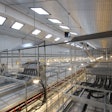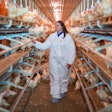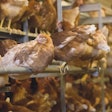
Egg Industry Insight has surveyed four pest control companies to find out the best way for egg producers to ensure fly activity is under control.
As more egg producers convert to cage-free systems, pest control companies have had to update their products and conduct new research to ensure they are meeting the demands of the industry.
According to Frank Jusich, Pertinent Eco-Solutions Head of Commercial Operations, cage-free production can make pest control more difficult because many products cannot be applied while the birds are present in the house.
To address this, Jusich recommends P3 Poultry Powder because it can be applied in the presence of birds and has a long-residual timeframe.
Danny McDonald, Ph.D., Control Solutions Inc. Tech Services Manager, believes pest control between the two housing types has many similarities. McDonald recommends that egg producers, no matter the housing type, keep the manure dry and set action thresholds when monitoring fly activity in a house.
If fly or pest activity is found, McDonald says producers should use insect growth regulators (IGRs), such as Tekko 10, to treat the manure. McDonald also suggested that producers apply a residual surface spray on surfaces where adult flies land and supplement those treatments with fly baits, misting or fogging with natural pyrethrins to kill adult flies.
“If birds are roaming freely throughout the house, fly baits will have to be used in either bait stations or limited to application in manure pits and outside of barns,” he said.
Proactive pest treatment is the best route of action
According to Anna Hansen, MGK Technical Services Support Specialist, fly control is often reactive. “With so many other things for producers to think about, flies tend to be toward the bottom of the list until they become a problem,” she said.
However, flies are easier to control with a proactive approach. To be proactive, Hansen recommends incorporating insect growth regulator NyGuard into pest treatment programs because it acts on the immature life stages of flies or other pests to prevent them from maturing and can be applied in the presence of birds.
Jusich added, “Manure should be regularly removed, as well as any excess organic material around the food bins and loafing areas. If the producer has an enclosed building, having screens and positive airflow will also help keep flies away from the animals.”
Fly control and Salmonella
Fly control is especially important in controlling Salmonella in poultry, explained Alissa Welsher, Ph.D., Elanco Food Safety Technical Advisor. According to research from the U.S. Department of Agriculture Research Services, there is potential for Salmonella to be transmitted from infected flies to cage-free birds if they are consumed.
“By controlling these pests, producers are not only supporting the health and welfare of the birds and workers, but they are helping to control Salmonella transmission within and between flocks,” Welsher stated.


















